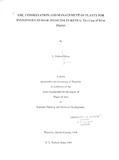| dc.description.abstract | The Kenyan population has been experiencing tremendous changes as its ecological
systems, economy, political and socio-culturallife responds to exigencies of development. In
the the sphere of health, the country continues to be thrown off balance by recent economic
crises. Introduction of Structural Adjustment Programmes (SAPS) since the 1980"s has meant
modem health care services are reaching fewer and fewer people in the rural areas.
Indigenous medicine (1M), which has continued to be utilised by the rural majority of the
population, seem to have maintained.its role as a provider of heaalth care. For 1M to
effectively meet the health needs of its users, medicinal plants and indigenous knowledge
which are essential components of 1M need to be conserved, and preserved.
The purpose of this thesis is to review the role of indigenous medicine as a
communityxutilised health care service in Kenya. It also aims to identify a representative
sample of medicinal plants utili sed in 1M and the conservation efforts being put both by the
users and the government. Field research undertaken in a small community in Eastern Kenya
leads to the conclusion that indigenous herbal medicine is extensively utilised by and is
preferred by 45% of the commuity. The observations from this study indicate that although
the government acknowledges the importance of 1M as a health care delivery service in
Kenya, the existing health policies are inadequate for its development. This inadequacy has
many negative effects on 1M resource base. Many medicinal plants utilised in 1M are being
destroyed through degradation of natural habitats due to pressures of modern development.
There are no appropriate natural resource management policies to conserve and manage these
medicinal plants which are the major element in herbal medicine practice. Similarly,
indigenous knowledge, which enables utilisation of plants in 1M is disappearing with the
passing of elders.
In order to develop 1M and its resource base, this thesis has suggested areas that can
be addressed to promote and enhance conservation of both medicinal plants and indigenous
knowledge in 1M. These include integration of participatory planning in Kenya's planning
system, partnership between community and the government in conservation efforts,
incorporation of health plans which are sensitive to development of 1M. These propositions
are expected to lead to national policies and plans that address the use, conservation and
management of plants and indigenous knowledge in 1M. This thesis also notes areas for
further study within Kenya to better understand and promote indigenous medicine resource
base within the larger context of indigenous knowledge system. | en |

